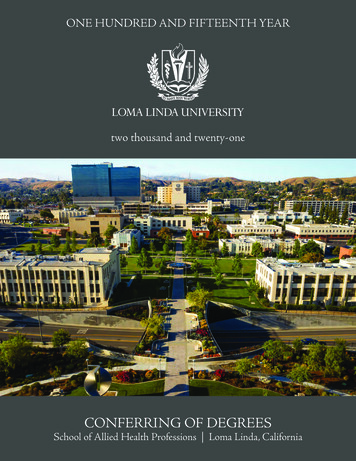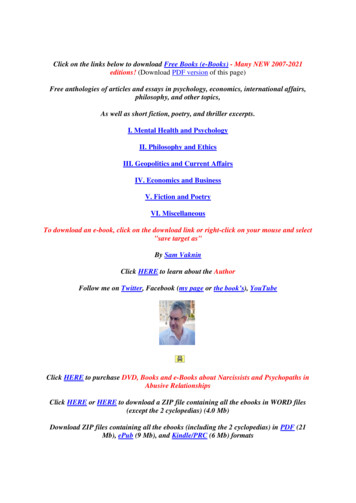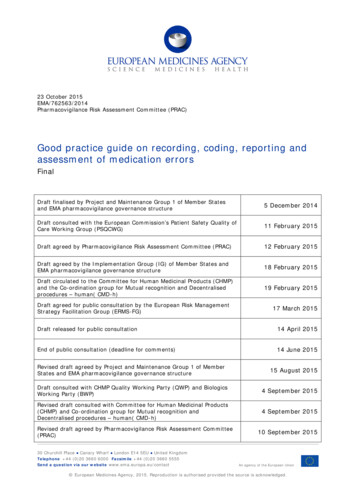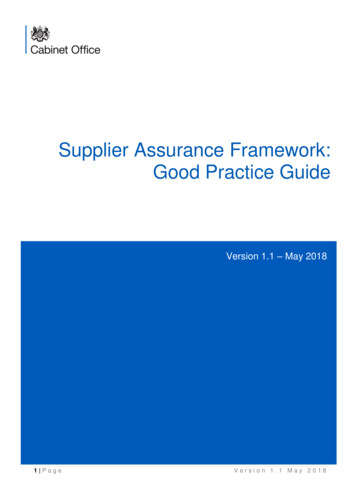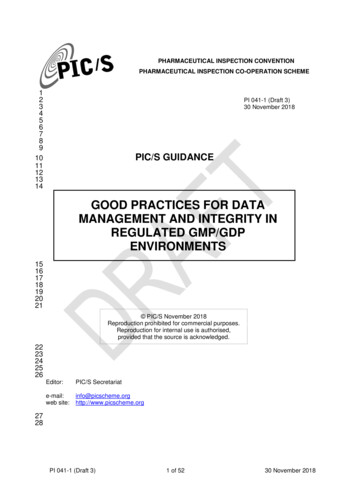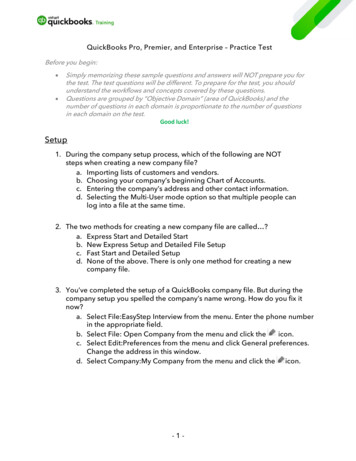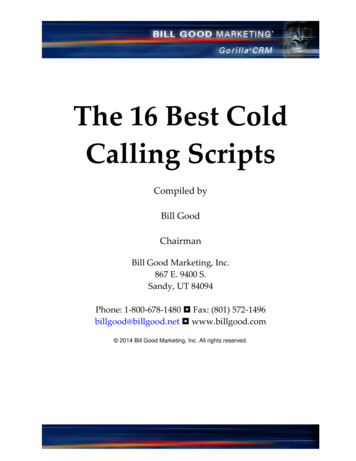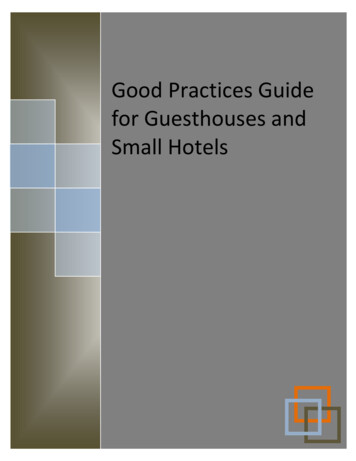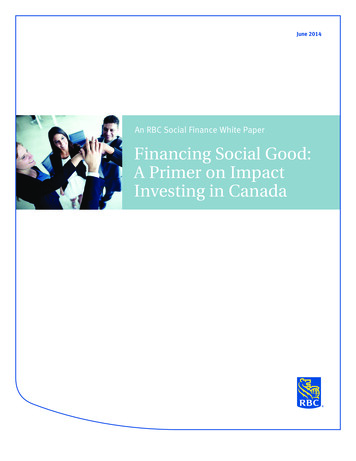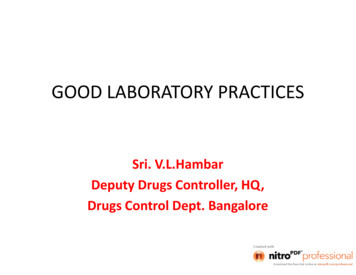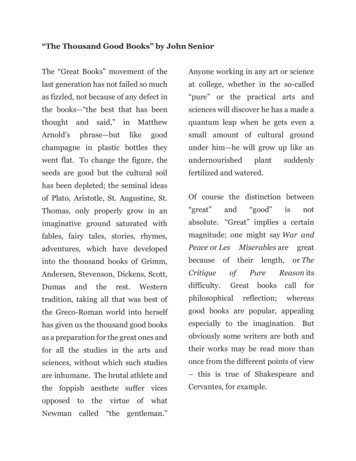
Transcription
“The Thousand Good Books” by John SeniorThe “Great Books” movement of theAnyone working in any art or sciencelast generation has not failed so muchat college, whether in the so-calledas fizzled, not because of any defect in“pure” or the practical arts andthe books—“the best that has beensciences will discover he has a made athoughtquantum leap when he gets even dsmall amount of cultural groundchampagne in plastic bottles theyunder him—he will grow up like anwent flat. To change the figure, theundernourishedseeds are good but the cultural soilfertilized and watered.plantsuddenlyhas been depleted; the seminal ideasof Plato, Aristotle, St. Augustine, St.Of course the distinction betweenThomas, only properly grow in an“great”imaginative ground saturated withabsolute. “Great” implies a certainfables, fairy tales, stories, rhymes,magnitude; one might say War andadventures, which have developedPeace or LesMiserables areinto the thousand books of Grimm,becausetheirAndersen, Stevenson, Dickens, sternandof“good”islength,Purebooksgreator TheReason itscallfortradition, taking all that was best ofphilosophicalthe Greco-Roman world into herselfgood books are popular, appealinghas given us the thousand good booksespecially to the imagination. Butas a preparation for the great ones andobviously some writers are both andfor all the studies in the arts andtheir works may be read more thansciences, without which such studiesonce from the different points of vieware inhumane. The brutal athlete and– this is true of Shakespeare andthe foppish aesthete suffer vicesCervantes, for example.opposed to thevirtue of whatNewman called “the gentleman.”reflection;notwhereas
It is commonly agreed also that bothundoubtedly“great” and “good” can only be judgedimportance inadvertently left out—fromdistance.butcanbesheet. Everyone will find more thanappreciated and enjoyed but not veryenough that he hasn’t read; andproperly judged, and just as aeverything on this list is by commonprinciple must stand outside whatconsent part of the ordinary culturalfollows from it (as a point to a line), somatter essential for an English-aspeaking person to grow thisisauthorsaofsufficientsomework-established from some time at least asdistant as our grandparents’. For usRemember that the point of viewtoday the cut-off point is World War Ithroughout a course of studies such asbefore which cars and the electricthis is that of the amateur—thelight had not yet come to dominateordinary person who loves and enjoysour lives and the experience of naturewhat he loves—not of the expert inhad not been distorted by speed andcritical,the destruction of shadows. There is atechnology.historicalortextualbeendividedserious question—with arguments onboth sides surely—as to whether thereThebookscan be any culture at all in a(sometimes dubiously because somemechanized society. Whichever sidestand midway between the categories)one takes in that dispute, it is certainlyinto the stages of life corresponding totrue that we cannot understand thethe classical “ages” of man and inpoint at issue without an imaginativegeneral agreement with the divisionsgrasp of the world we have lost.ofmodernhavechildpsychologyasexplained by Freud or Piaget. AndWhat follows is not a completebecause sight is the first of the senseslist:almost all the authors haveand especially powerful in early years,written many books, some as good asit is very important to secure bookstheillustrated by artists working in theonesgiven;andthereare
cultural tradition we are studyingRandolph Caldecott, Kate Greenaway,both as an introduction to art and asWalter Crane, Gustave Dore, Georgepart of the imaginative experience ofCruikshank, “Phiz”, Gordon Browne,the book. This is not to disparageBeatrix Potter, Sir John Tenniel,contemporary artists any more thanArthur Rackham, Howard Pyle, N.C.theWyeth, and many others.traditionitselfdisparagescontemporary experiment—quite thecontrary, one of the fruits of such aThe rule of thumb is to find acourse should be the encouragementnineteenth-century edition or one ofof good writing and drawing.Athe facsimiles which (though not asstandard must never be taken as asharp in the printing) are currentlyrestrictive straitjacket but rather as aavailable at moderate prices. Whatteacherforfollows is an incomplete work-sheet ofillustrationunedited notes which may serve as nineteenth century in the work ofrough guide.
SENIOR’S INCOMPLETE LIFE-LONG READING LISTTHE NURSERY (Ages 2 – 7)Literary experience begins for very young children with someone reading aloudwhile they look at the pictures. But they can begin to read the simplest storieswhich they already love at an early age.Aesop. Aesop’s Fables (The translation by Robert L’Estrange is the classic).Andersen, Hans Christian. Fairy Tales.Arabian Nights. There are two classic translations, one expurgated for childrenby Andrew Lang, the other complete by Richard Burton.Belloc, Hilaire. The Bad Child’s Book of Beasts; Cautionary Tales.Caldecott, Randolph. Picture Books, 16 little volumes (published by FrederickWarne).Carroll, Lewis. Alice in Wonderland; Through the Looking Glass. Illustrated byTenniel.Collodi, Carlo. Pinocchio.de la Mare, Walter. Come Hither; Songs of Childhood.Edgeworth, Maria. The Parent’s Assistant; Moral Tales.Ewing, Juliana. Jackanapes.Gesta Romanorum. Translated by Swann (scholarly facsimiles).Grahame, Kenneth. Wind in the Willows (illustrated by Ernest Shepherd).Greenaway, Kate. Apple Pie; Birthday Book; Marigold Garden; MotherGoose; Under the Window; The Language of Flowers (Frederick Warne).Grimm. Household Stories. Illustrated by Walter Crane (Dover facsimiles).Harris, Joel Chandler. Uncle Remus.Kingsley, Charles. Water Babies.Kipling, Rudyard. Just So Stories; Jungle Book.Lamb, Charles. Beauty and the Beast; Tales from Shakespeare.Lang, Andrew. Blue Book of Fairies and other colors; five volumes; bestillustrated by H.J. Ford (Dover facsimile).
Lear, Edward. Nonsense Omnibus; The Owl and the Pussycat. Illustrated byLear (Warne).Lofting, Hugh. Dr Doolittle’s Circus and others in the series.Milne, A.A. Winnie the Pooh and others in the series.Mother Goose (Dover facsimiles – illustrated by Rackham; Viking Press).Perrault, Charles. Fairy Tales. Illustrated by Dore (Dover).Potter, Beatrix: Peter Rabbit and 23 little volumes; some available in French,Spanish and Latin. All illustrated by Potter (an important feature of these booksis their small size, designed for a young child. Buy the individual books, not all ofthem collected in one big volume).Stevenson, Robert Louis. A Child’s Garden of Verses (Scribners).SCHOOL DAYS (Ages 7 – 12)Adams, Andy. Log of a Cowboy. Illustrated by N.C. Wyeth.Alcott, Louisa May. Little Women; Little Men; others.Aldrich, Thomas Bailey. Story of a Bad Boy.Burroughs, Edgar Rice. Tarzan series.Browning, Robert. The Pied Piper of Hamelin. Illustrated by Kate Greenaway(Warne).Burnett, Francis Hodgson. The Secret Garden; Little Lord Fauntleroy.Collins, William. John Gilpin’s Ride. Illustrated by Caldecott (Warne).Cooper, James Fenimore. Deerslayer and many others.Dana, Richard Henry. Two Years Before the Mast.Dickens, Charles. Christmas Carol; Cricket on the Hearth; DavidCopperfield; Oliver Twist (These last may be reserved for adolescents or re-read.)Dodge, Mary Mapes. Hans Brinker.Defoe, Daniel. Robinson Crusoe.Garland, Hamlin. Son of the Middle Border and others.Hawthorne, Nathaniel. Tanglewood Tales.Henty, George William. A hundred “Boys Books”.
Irving, Washington. Sketch Book.James, Will. Smoky; Lone Cowboy; Book of Cowboys Illustrated by James.Kingsley, Charles. Westward Ho, othersKipling, Rudyard. Captains Courageous; Stalky and Co. Illustrated by Millar.Longfellow, Henry Wadsworth. Hiawatha; Evangeline.Marryat, Frederick, Midshipman Easy; Masterman Ready, and others.Masefield, John. Jim Davis.Porter, Gene Stratton. Freckles and others.Pyle, Howard. Robin Hood and others. Illustrated by Pyle.Sewell, Anna. Black Beauty.Shakespeare. Comedy of Errors.Spyri, Johanna. Heidi.Stevenson, Robert Louis. Treasure Island; Kidnapped, and others. Illustrated byN.C. WyethStowe, Harriet Beecher. Uncle Tom’s Cabin.Tarkington, Booth. Penrod and others in the seriesTil Eulenspiegel translated by Mackenzie.Twain, Mark. Tom Sawyer; Huckleberry Finn; The Prince and the Pauper – butnot Connecticut Yankee and later novels.Verne, Jules. Around the World in Eighty Days; and many others.Wilder, Laura Ingalls. Little House on the Prairie; and others.Wyss, Johann. Swiss Family Robinson.ADOLESCENCE (Ages 12 – 16)Bronte, Emily. Wuthering Heights.Collins, Wilkie. Moonstone and others.Dampier, William. A Voyage Round the World.Daudet, Alphonse. Tartarin, Fromont Jeune.Dickens, Charles. Barnaby Rudge; Nicholas Nickleby; Old Curiosity Shop.Doyle, Arthur Conan. Sherlock Holmes series; White Company.
Du Maurier, George. Trilby.Dumas, Alexander. Three Musketeers; others.Eggleston, Edward. The Hoosier Schoolmaster.Eliot, George. Romola; Adam Bede; Mill on the Floss.Fabre, Henri. Selections from Souvenirs entymologique.Hughes, Thomas. Tom Brown’s School Days; Tom Brown at Oxford.Hugo, Victor. Quatre-vingt-treize; Les Miserables; Hunchback of Notre-Dame.Ibanez, Blasco. Blood and Sand; Four Horsemen of the Apocalypse.Le Sage, Alain. Gil Blas.Park, Mungo. Travels in Africa.Parkman, Francis. Oregon Trail.Poe, Edgar Allen. Tales; and poems.Polo, Marco. Travels.Reade, Charles. The Cloister and the Hearth.Rhodes, Eugene. Best Novels and Stories (edited by Dobie).Scott, Walter. Ivanhoe; Rob Roy; many others.Shelley, Mary. Frankenstein.Shakespeare. Midsummer Night’s Dream; Romeo and Juliet; Merchant ofVenice.Sienkiewicz, Henryk. Quo Vadis; With Fire and Sword.Swift, Jonathan. Gulliver’s Travels.Wallace, Edgar. Four Just Men; Sanders of the River; others.Wells, H.G. The Time Machine; The Invisible Man; others.Wister, Owen. The Virginian.YOUTH (Ages 16 – 20)Austen, Jane. Pride and Prejudice; and others.Balzac, Honore. Pere Goriot; and many others.Bellamy, Edward. Looking Backward.Bernanos, Georges. Diary of a Country Priest.
Blackmore, Richard. Lorna Doone; and others.Borrow, George. Romany Rye; and others.Bronte, Charlotte. Jane Eyre.Buchanan, John. The Thirty Nine Steps; and many others.Butler, Samuel. The Way of all Flesh; Erewhon.Cabell, James Branch. Jurgen; and others.Cable, George Washington. Old Creole Days; and others.Cather, Willa. My Antonia; Death Comes for the Archbishop; and others.Chekhov, Anton. Stories; and plays.Chesterton, G.K. Father Brown series; Everlasting Man; A Man CalledThursdayColumbus, Christopher. Four Voyages to the New World.Conrad, Joseph. Lord Jim; and many othersCook, James. Captain Cook’s Explorations.De Maupassant, Guy. Stories.Dickens, Charles. Bleak House; Our Mutual Friend; Martin Chuzzlewit.Dostoyevsky, Feodor. Crime and Punishment; Brothers Karamazov.Doughty, Charles. Travels in Arabia Desert.Fielding, Henry. Tom Jones; Jonathan WildeHakluyt, Richard. Voyages to the New World.Hawkins, Anthony Hope. The Prisoner of Zenda.Hawthorne, Nathaniel. Scarlet Letter; and others.Irving, Washington. Life of Columbus; Conquest of Granada; Life of GeorgeWashingtonJackson, Helen Hunt. Ramona.Lagerof, Selma. Jerusalem; Gosta Berling; and others.Loti, Pierre. Iceland Fisherman; and others.Manzoni., Alessandro. The Betrothed.Melville, Herman. Moby Dick; Billy Budd; and others.Moore, Tom. Lalla Rookh.
Morris, William. News from Nowhere.Scott, Robert. Scott’s Last ExpeditionShakespeare. MacBeth; Hamlet; Taming of the Shrew; As You Like It.Stendahl. The Red and the Black; The Charterhouse of Parma.Stanley, Henry Morton. How I Found Livingstone.Thackeray, William Makepeace. Vanity Fair; Henry Esmond; and others.Tolstoy, Leo. War and Peace; and others.Trollope, Anthony. Barchester seriesTurgenev, Ivan. Fathers and Sons; A Nest of Gentlefolk; and others.Undset, Sigrid. Kristin Lavransdatter; and others.Verga, Giovanni. The House by the Medlar Tree; and others (translated by D.H.Lawrence)Washington, Booker T. Up from Slavery.SPIRITUAL READING (All ages)The Bible. For cultural purposes, there are only two English Bibles: for theProtestants the King James Version and for Catholics the Douay-Rheims. Bothare literary masterpieces as none other even remotely is. Since spiritual mysteriescan only be communicated through poetry, whatever more modern versions maygain in accuracy is nothing compared to what is lost.Bunyan, John. Pilgrim’s Progress—the Great Protestant Masterpiece.de Sales, St Francis. Introduction to the Devout Life—the best there is.MUSICAvoiding extremes of difficult and light—neither Bach nor Debussy—thedistinction between “great” and good is blurred. The student should listen to onework only for at least a week, going over and over the separate movements or actsuntil the repeated themes are recognized as they recur. It is better to know a veryfew works very well than to run over vast amounts. The following is a good orderfor neophytes:
Beethoven. Violin Concerto.Beethoven. Pastoral Symphony.Verdi. Rigoletto.With an opera, read the entire libretto in English, then take only a single sceneand play it through several times trying to follow the words in Italian (or Frenchor German) with an understanding of their meaning. Having gone through thewhole opera scene by scene, pick out great moments – arias, duets, etc. It is goodto have two recordings, one of the complete work, another of the highlights.Puccini. La BohemeMozart. Clarinet Concerto or Oboe Concerto; Jupiter Symphony; Piano music(especially as played by Gieserking)Beethoven. Seventh Symphony.Brahms. Fourth Symphony.Chopin:. Selections.(Most important: Students should attend live concerts).ARTThe Kenneth Clark series Civilisation. Clark published a book with illustrationsand the text of the series. And most important, visits to museums and galleries.
“The Thousand Good Books” by John Senior The “Great Books” movement of the last generation has not failed so much as fizzled, not because of any defect in the books—“the best that has been thought and said,” in Matthew Arnold’s phrase—but like good champagne in
